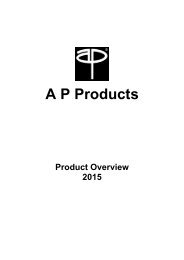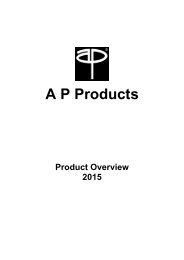Gesamtkatalog 2016-2
Create successful ePaper yourself
Turn your PDF publications into a flip-book with our unique Google optimized e-Paper software.
2mm HPM Series<br />
Application Notes<br />
Shroud Orientation<br />
When shrouds are used on the rear of the backplane, care must be taken to align the shrouds properly. The correct orientation<br />
will depend upon the configuration of the rear plug-in cards. For most applications following the “inline” configuration, the rear<br />
shrouds will have the convex and detail facing down as depicted in the circle in Figure 3. The “a” row of the shroud will match the<br />
“a” row of the male connector. This preferred orientation of the shroud will enable the cable system to be securely latched on the<br />
left side when viewing from the rear of the backplane, as shown in Figures 1 and 2.<br />
Figure 3<br />
These Application Notes are intended to explain differences in numbering schemes commonly used with the extended 2mm HM series for<br />
I/O applications. The importance of these differences is to qualify the wiring issues surrounding single-ended and double-ended assemblies,<br />
as well as single- ended applications requiring labels on the unterminated end. The figures 1 and 2 on pages 13 and 14 clearly present the<br />
differences existing between the two standards that currently employ the 2mm HM connector system.<br />
VME64x Applications<br />
The IEEE 1101.10 Standard employs the same 19-position 2mm family of connectors as is used in VME64x applications. This center connector,<br />
located in slot JO/PO for VME64x backplane layouts shown below in figure 2 reveals pinout assignments with Row/Position A1 located<br />
at the top slot 1 edge of the pinfield. The depictions below describe the front and rear views respectively, and the corresponding A1 Location. This<br />
clarification is needed to properly identify where A1 is located with respect to the cable assembly and application being employed. Note that the<br />
latches, which ruggedize the interface, are depicted on the left side of the shroud when viewing the slots from the rear.<br />
Figure 2<br />
Figure 2 - VME64x Backplane Layout<br />
18<br />
18<br />
20<br />
20<br />
22<br />
22<br />
24<br />
24<br />
26<br />
26<br />
28<br />
28<br />
30<br />
30<br />
32<br />
32<br />
2mm HM<br />
header w/<br />
feed through<br />
pins<br />
VME 64X<br />
backplane<br />
ERNI Shroud<br />
1<br />
1<br />
1<br />
1<br />
1<br />
1<br />
19<br />
ZABCDEF<br />
ZABCDEF<br />
19<br />
ZABCDEF<br />
19<br />
ZABCDEF<br />
1.85<br />
a1<br />
2<br />
4<br />
19<br />
FEDCBAZ<br />
a1<br />
2<br />
4<br />
19<br />
FEDCBAZ<br />
FEDCBAZ<br />
19<br />
FEDCBAZ<br />
Front<br />
ERNI<br />
latch arm<br />
064219<br />
Rear<br />
Front View<br />
6<br />
8<br />
10<br />
12<br />
14<br />
6<br />
8<br />
10<br />
12<br />
14<br />
Rear View<br />
Latch View<br />
(side)<br />
Facing Row F<br />
position 1 through 19<br />
top to bottom<br />
PICMG 2.1 R3.0 specifies an<br />
AB19 shroud for rear plug in<br />
applications (rP3/rJ3).<br />
However, cable assemblies<br />
used for I/O routing<br />
currently require a B19 shroud.<br />
A P Products GmbH, Bäumlesweg 21 – 23, 71093 Weil im Schönbuch, Germany<br />
Tel: +49-7157-5348-0, Fax: +49-7157-5348-39, Web: www.ap-products.de, E-mail: info@ap-products.de





